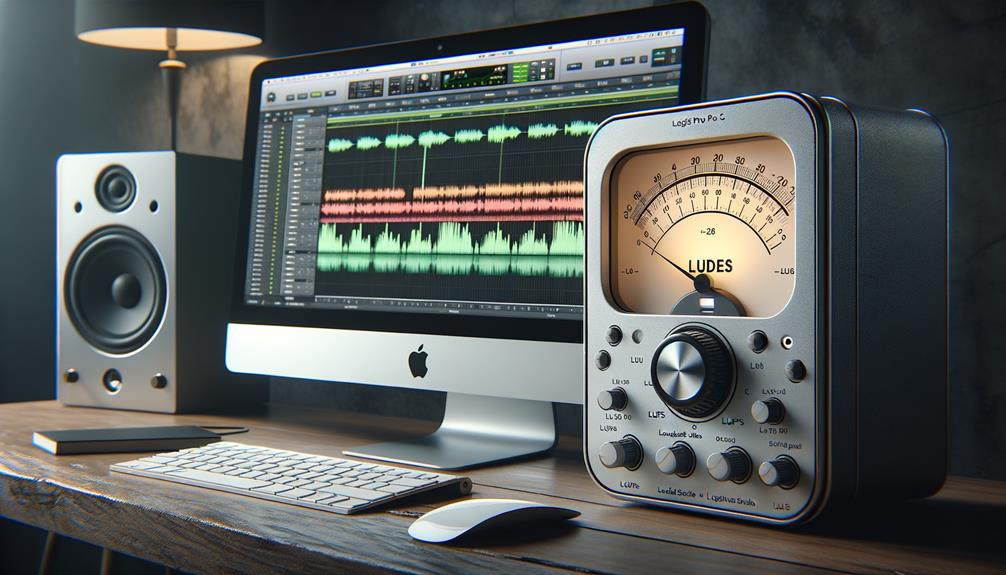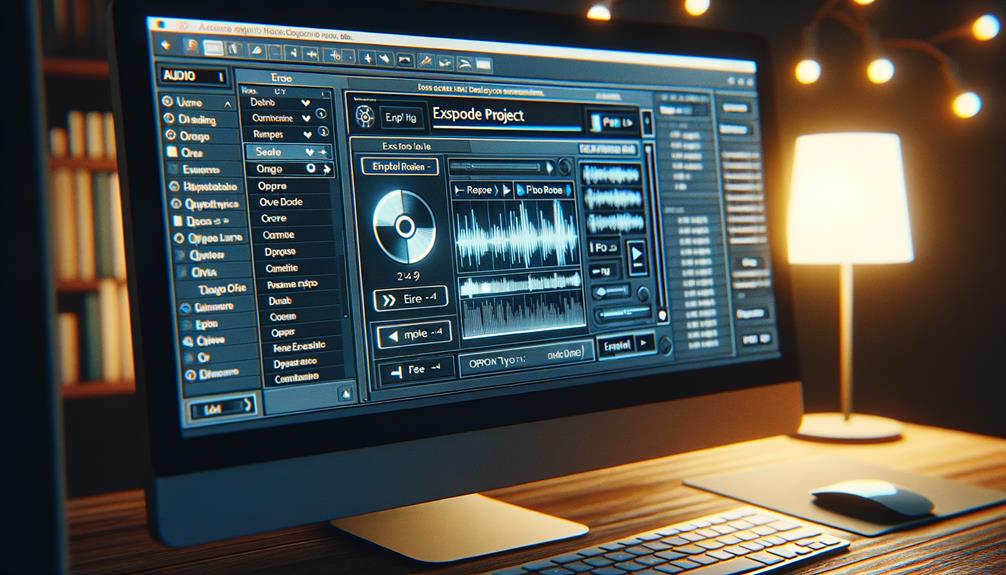No products in the cart.
Mastering in Logic Pro X requires attention to detail and a nuanced understanding of the software’s capabilities.
There are several key techniques and tools that can elevate your mastering process to a professional level.
From gain staging your reference tracks to utilizing the Match EQ tool and setting the desired loudness, each step plays a crucial role in achieving a polished and refined sound.
Understanding how to take advantage of Logic Pro X’s Adaptive Limiter and export the correct file type can make all the difference in the final product.
These are just the beginning steps to mastering in Logic Pro X, and there’s much more to explore in order to achieve a truly professional sound.
Contents
hide
Key Takeaways
- Importing a reference track and aligning its peak level can help guide the mastering process and ensure a balanced mix.
- Matching the tonal balance of your mix to that of the reference track using EQ plugins can help achieve a more professional sound.
- Utilizing Logic Pro X’s Match EQ tool allows you to analyze the frequency spectrum of a reference track and apply the same EQ curve to your mix, resulting in a well-balanced sound.
- Using loudness metering and Logic’s Adaptive Limiter can help set the desired loudness level while maintaining dynamics and avoiding distortion.
Gain Staging Your Reference Tracks
When gain staging your reference tracks in Logic Pro X, it’s crucial to ensure that the levels are set accurately to provide a clear and reliable point of reference for your mixes.
Start by importing your reference track into Logic Pro and aligning its peak level with that of your own mix. Use the gain plugin in your chain to adjust the level of the reference track, ensuring that it doesn’t overpower your mix.
Next, focus on tonal and frequency balance. Use the EQ plugins in Logic Pro to match the tonal balance of your mix to that of the reference track. Pay close attention to the frequency spectrum, making adjustments to achieve a similar frequency balance.
Additionally, utilize a loudness meter to compare the overall loudness of your mix with the reference track. This will help you achieve a competitive and commercially viable master.
Utilize Logics Match EQ Tool
To achieve a similar tonal balance within your mix, utilize Logic’s Match EQ tool to analyze the frequency spectrum of a reference track and apply the same EQ curve, experimenting with settings and adjusting the match intensity for a well-balanced sound. Incorporate the Match EQ plugin in your chain and make adjustments to match the tonal balance of your mix with the reference track.
This innovative feature allows you to precisely match the frequency spectrum of your reference track, ensuring your mix achieves a similar tonal balance.
Once you have utilized the Match EQ to apply the desired EQ curve, consider using a gain plugin to adjust the overall volume to match the reference track. After making these adjustments, you can proceed with the final plugin in your mastering process.
For instance, Logic’s Adaptive Limiter can be used to ensure that your mix is at the appropriate loudness level without sacrificing the tonal balance achieved with the Match EQ tool.
Set Your Loudness

You can use loudness metering to accurately set the desired loudness level for your mix. In Logic Pro X, the Adaptive Limiter is a powerful tool for mastering and controlling the loudness of your final mix. This plugin allows you to make precise adjustments to the gain, ensuring that your song meets industry standards and is optimized for the intended playback platform.
When mastering your tracks, it’s essential to use the Adaptive Limiter to maintain the dynamics of the mix while maximizing the overall loudness without introducing distortion. Experiment with the threshold and release settings to achieve the perfect balance of dynamics and loudness.
Additionally, be mindful of the target medium, whether it’s streaming, CD, or another format, as this will impact the optimal loudness level for your final mix. Once you’ve set the loudness to the correct level, you can export your mastered file by going to File > Export > The Correct format for your intended distribution platform.
Logic Pro X’s Adaptive Limiter and precise metering tools are essential for achieving professional and competitive loudness levels in your music.
Take Advantage Of Logics Adaptive Limiter
For achieving professional and competitive loudness levels in your music, mastering the use of Logic’s Adaptive Limiter is essential. This powerful mastering tool allows you to control dynamics and maximize loudness without introducing distortion. By experimenting with the threshold and release settings of the Adaptive Limiter, you can achieve optimal results and ensure that your music maintains its clarity and impact.
| Adaptive Limiter Settings | Description |
|---|---|
| Threshold | Adjust this setting to control when the limiter starts to take effect. Lowering the threshold increases the gain reduction, bringing the overall level of the audio closer to the desired loudness. |
| Release | This setting determines how quickly the Adaptive Limiter stops compressing the audio once it falls below the threshold. Fine-tuning the release can help maintain the natural dynamics of the music while still achieving the desired loudness. |
Maximize loudness without distortion by using Logic’s Adaptive Limiter. This tool is particularly valuable for mastering engineers working on a wide range of audio material. When mastering in Logic Pro, it’s crucial to ensure that your audio file has sufficient headroom to accommodate the gain reduction applied by the Adaptive Limiter. Mastering engineers can take advantage of the Adaptive Limiter to achieve a polished and professional sound while maintaining the integrity of the original audio.
Export The Correct File Type


When exporting your mastered track, ensure to select the appropriate file format that aligns with the intended use and platform compatibility.
Consider the following when exporting your mastered track:
- Quality and Compatibility: Choose the file type (MP3, WAV, etc.) that best suits the desired quality and is compatible with different devices and platforms.
- Guidelines and Recommendations: Follow any specific guidelines or recommendations from the distribution platform or mastering engineer regarding the export file type to ensure it meets industry standards.
- Playback Systems: Prioritize the correct file type to ensure the best representation of your mastered track across various platforms and devices, especially when preparing it for streaming services.
Frequently Asked Questions
Can You Master With Logic Pro?
Yes, you can master with Logic Pro. Utilize Logic Pro plugins for EQ mastering and compression methods. Apply mastering techniques like gain staging and Loudness Metering for final mastering. The software offers powerful tools for audio mastering.
How Do I Master a Project in Logic Pro X?
To master a project in Logic Pro X, use mastering plugins, dynamic range, and frequency balance techniques. Optimize your signal chain, adjust loudness levels, and perfect stereo imaging. Employ mastering EQ techniques for a top-notch mastering workflow.
How Do You Master Volume in Logic Pro?
To master volume in Logic Pro, you’ll use volume automation, mixing techniques, signal chain, EQ adjustments, compression settings, stereo imaging, bus routing, limiting options, reference tracks, and mastering plugins to achieve the desired sound.
Is Logic Pro X Good for Beginners?
Logic Pro X is great for beginners. Its basic interface, MIDI editing, audio recording, mixing tracks, automation tools, virtual instruments, audio effects, tempo mapping, time stretching, and arrangement view offer a comprehensive platform for learning music production.
Conclusion
In conclusion, mastering in Logic Pro X requires attention to detail and utilization of the tools available.
By gain staging reference tracks, utilizing the Match EQ tool, setting the desired loudness, taking advantage of the Adaptive Limiter, and exporting the correct file type, you can achieve a professional and polished sound in your mastered tracks.
With practice and experimentation, you can use Logic Pro X to enhance and refine the overall sound of your music.




